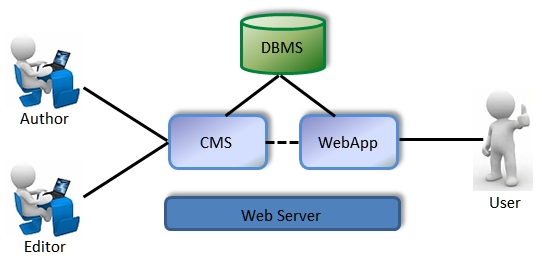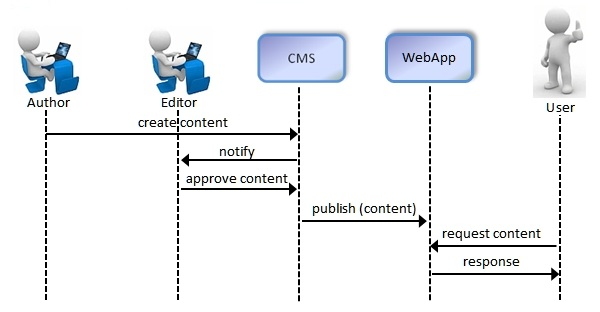Section 0: Module Objectives or Competencies
| Course Objective or Competency | Module Objectives or Competency |
|---|---|
| The student will be able to compare and contrast alternative approaches to web application design, including Web Science, Web Engineering, the use of Web Content Management Systems, and others. | The student will be introduced to Web Content Management Systems to provide the infrastructure support required for creating and managing web content for large, dynamic web applications. |
Section 1: WCMS
In the early days of the Internet, website content typically consisted of static web pages and other documents that could be read online or downloaded.
Modern web applications, however, are highly dynamic, interactive, and content driven.
- Web content comes in a variety of forms, including documents, images, audio and video clips, blogs, forums, and so on.
- Content also changes very frequently as new content is created, old content is archived, or newer versions of existing content come along.
- The process of producing web content may require the coordination of many people with different skills and roles.
Web Content Management Systems (WCMS) provide the infrastructure support required for creating and managing web content for large, dynamic web applications.
A WCMS enables an organization to update its website quickly and easily, without needing specialist skills like knowledge of HTML or CSS.
- This allows organizations to keep frequently changing information, such as prices, product specifications or news, updated without having to pay a third party to make each change.
- More importantly for this discussion, a WCMS makes content authoring and content delivery easy, enabling even non-technical users to efficiently build a website, streamline the web publishing procedures, and quickly deploy them to create a content-rich website.
Here is a Video Introduction to WCMS.
A web content management solution simplifies the process by which content contributors create, publish, and update website content. Web content management solutions enable people beyond the web team to maintain website content by distributing the effort into the hands of the content contributors who are ultimately responsible for the content. Put simply, a web content management system:
- Simplifies the process of creating, publishing and updating web content,
- Enables both non-technical and technical staff to participate,
- Decreases the time and costs associated with web content maintenance.
WCMS provides a variety of services, including:
- Content Tracking: Content is cataloged and identified throughout its life cycle, and made available to owners.
- Workflow and Collaboration Management: If a series of steps is required to generate new content (authoring, editing, formatting, approval, etc.), the CMS can enforce the correct sequence, support sharing of documents in progress, and automatically notify individuals of pending work and work status.
- Versioning: Different versions of a single document (e.g., a user manual) can be made available to users.
- Formatting: A CMS can apply standard formatting (font, color, trademarks, etc.) in order to enforce consistency and to simplify the task of authoring by separating content from format.
- Archiving: When documents become obsolete, they can be removed from public access and archived for future reference.
- Blogs, Forums, Wikis, and so on: User-generated content may also be managed directly by a CMS as an extension of a web application.
Web content management systems bring several benefits to organizations that use them.
- First, they bring efficiency to the process of creating and deploying web content by reducing the number of steps required, reducing the degree of technical support required, and by automating the process.
- Second, they help to manage the content development process by enforcing correct workflow and authorization protocols.
- Third, they help to establish a brand image by enforcing standard configuration and appearance of web content.
- Fourth, they enable the creation of content in popular formats without requiring custom application programming to create and deploy it.
A WCMS is in itself a web application. The following figure shows an architectural view of a typical WCMS that executes as a web application.

- The CMS provides direct access to internal users only and may provide services (such as blog support) to other web applications.
- Content may be stored directly in a DBMS or may be cataloged in a DBMS and stored in a file repository.
The figure below illustrates the role of the CMS in publishing web content.

- In a typical transaction, an author originates new content and then the appropriate collaborator is notified by the CMS of a request for approval.
- After content is approved the CMS publishes it, making it available for users to access.
There are dozens of CMS available, both open source and proprietary.





